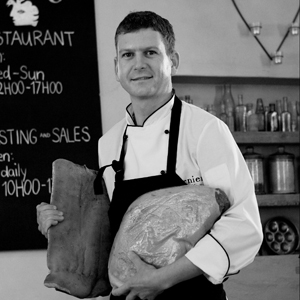The heat in our part of the world over Christmas makes it less than ideal for a traditional Christmas roast lunch or even dinner, certainly my family would be happier to braai crayfish at our beach house in Betty’s Bay.
The hot blooded Italians have a great enriched bread called Panettone that they traditionally eat over Christmas. Not only fantastic to eat but so beautiful, and with a little bit of trouble, you can make a few extra ones as gifts.
Do not be alarmed by the long list of instructions, I tried to be as thorough as possible so that even inexperienced bread bakers will soon feel like the new Mr. Poilane (a famous Parisian baker) themselves! You can get all the kids involved in making the starter, feeding it, kneading, shaping, baking and finally EATING the panettone.
Otherwise just give me a call on
021 880 0557 at Bodega to collect the starter.
The bread takes some time to make, but in return for your effort, it lasts a couple of weeks and it makes the most delicious bread and butter pudding when it goes stale.
It is nice enough to eat on its own, but is also delicious with strong cheese.
A week before you need the panettone, make the wild yeast culture- this is a fascinating bit of alchemy, because everywhere there are different strains of yeast floating in the air, the acid they create whilst fermenting the flour gives the bread a remarkable taste and makes the bread last longer.
Day one:
Mix 1 cup Eureka Mills Rye flour with ¾ cup of water at room temperature. Mix into a very stiff ball and place in a large measuring jug covered with cling film. Leave in a warm place like a kitchen counter until the next day.
Day two
Mix 1 cup Eureka Mills stone ground White Bread Flour with ½ cup water and add to Day one mixture, mixing with your hands until everything is evenly mixed. The dough will be less stiff than that of day one. Leave in a warm place until the next day.
Day three
The dough might have started to rise a little bit, this means the wild yeasts are starting to party. Remove half of the starter, and give it to a friend who is interested in baking bread. Add to the remaining starter 1 cup White Bread Flour and ½ cup water and mix very well.
Day four
By now the starter should be dancing, ideally it should have doubled in size, even more sometimes. Take 1 cup seed culture and add 2 cups water and 3 ½ cups White Bread Flour. Mix very well, it will be a sticky wet sponge. Transfer to a mixing bowl large enough to hold the starter, remember it will more than double in size. Cover with cling film and leave in a warm place to ferment for about 6 hours, the plastic wrap will balloon as a result of gas given off during the natural fermentation process. Let the gas escape, cover again with cling film and keep overnight in the fridge.
Pannettone
Now you can finally start with making the panettone, but you will have to wait until tomorrow to bake it! The quantities are enough for two large ones.
Stir together 1 cup of the starter with 1 cup milk, 1 cup White Bread Flour and 1 g saffron until well mixed and cover with plastic wrap. Leave for 4 hours in a warm place until nicely frothy, then place in the fridge overnight. Mix all the fruits and brandy and leave until the next day so they can absorb all the liquids and swell up: 1 cup golden sultanas, 1 cup mixed candied peel, 1 cup glace cherries and 1 cup diced preserved green figs, ½ cup brandy and the seeds scraped from one vanilla pod.
On baking day, remove the dough from the fridge for at least an hour before you start, and ½ cup unsalted butter to soften while you can go for a nice long stroll on the beach.
In a large mixing bowl, stir together 3 cups White Bread Flour, 3 Tablespoons sugar, ¾ teaspoon salt and 1 packet instant yeast. Add the sponge and one egg plus another yolk. Mix until you end up with a smooth dough, leave for 20 minutes to rest and then add the softened ½ cup unsalted butter, squeeze and knead until there are no more visible splotches of butter, then add the soaked fruits with their liquids and 1 cup blanched almonds and knead in until evenly distributed through the dough. It should be smooth but not too sticky, and the kneading should not take more than about 7 or 8 minutes. Let ferment for 2 hours in a warm place, it will rise slowly to about 1,5 times its size.
Line 2 large spring form cake tins with lightly buttered greaseproof paper. Divide the dough into two equal pieces and shape into rounds, then place inside the lined tins, pressing down a little bit to smooth the tops. Place a clean plastic bag over the top and let proof for about 2 hours in a warm place until the dough almost reaches the top of the tins.
Preheat the oven to 180 C. Place the oven rack in the lower third of the oven and bake the breads for 1h30 min. If after 45 minutes the tops looks like they’re getting too dark brown, loosely cover with tin foil and continue baking. Remove from the baking tin and place on a wire rack to cool for at least 2 hours. You can now eat them or keep them in a paper bag in a biscuit tin for about one week.
Merry Christmas from the Bodega Kitchen Team!

